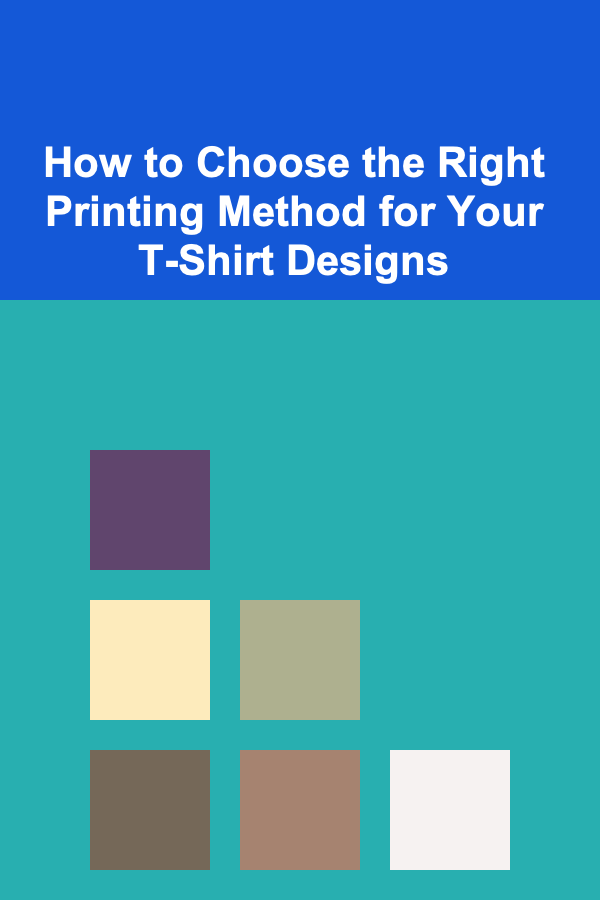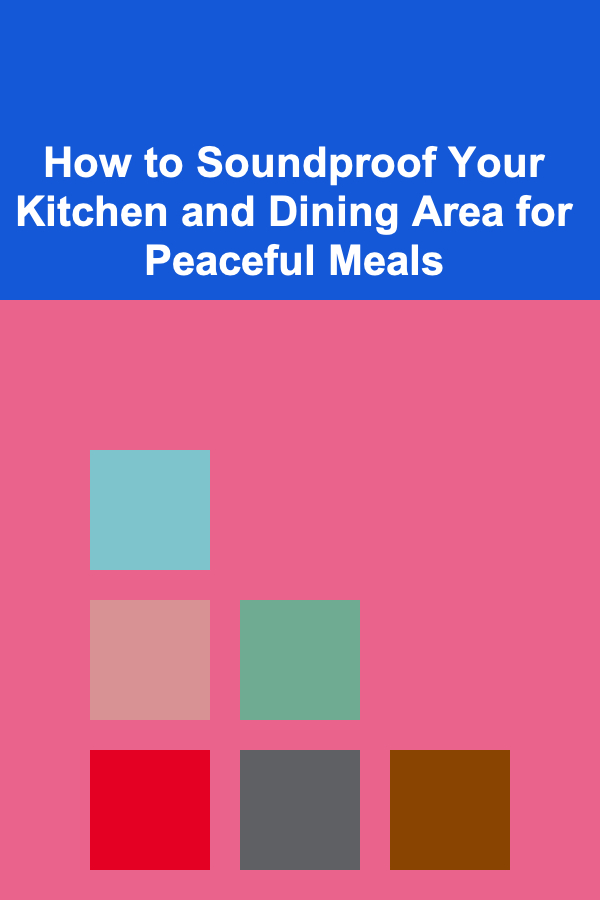
How to Choose the Right Printing Method for Your T-Shirt Designs
ebook include PDF & Audio bundle (Micro Guide)
$12.99$8.99
Limited Time Offer! Order within the next:

When it comes to bringing your t-shirt designs to life, selecting the right printing method is crucial. It directly impacts the quality, durability, cost, and overall appeal of the final product. Whether you're a graphic designer, a small business owner, or an entrepreneur launching your own clothing brand, understanding the different printing methods is essential for making the best decision.
In this actionable guide, we'll break down the most popular printing methods, their advantages, and how to choose the right one based on your design needs, budget, and long-term goals.
Understanding Your Design and Needs
Before diving into the specifics of each printing method, it's important to consider a few key aspects of your design and overall business needs. Ask yourself the following questions:
- How intricate is the design?
- What is the quantity of t-shirts you plan to print?
- What is your budget for printing?
- What is the intended use of the t-shirts (e.g., fashion, promotional, events)?
- What is the desired feel and durability of the print?
The answers to these questions will help you determine the most suitable printing method for your project. Let's explore some of the most common t-shirt printing techniques.
Screen Printing
Overview
Screen printing is one of the oldest and most popular methods for t-shirt printing. It involves creating a stencil (or screen) and using it to apply layers of ink onto the printing surface. The process is repeated for each color used in the design.
Advantages
- Durability: Screen printing produces vibrant, long-lasting prints. The ink bonds well with the fabric, making it resistant to fading over time.
- Cost-effective for large runs: The more t-shirts you print, the cheaper the cost per unit becomes.
- Great for simple designs: Screen printing is ideal for designs with few colors and bold, clean lines.
Disadvantages
- High setup costs: Screen printing requires custom screens for each color, making it expensive for small orders or multi-color designs.
- Limited color range: While vibrant, the number of colors you can use in screen printing is limited by the number of screens, making it less suitable for complex, multi-colored designs.
- Not ideal for small quantities: Due to setup costs, it's generally not recommended for orders fewer than 20-30 t-shirts.
Best for:
- Large orders with simple designs
- Bold, graphic designs or logos with few colors
- Long-term durability
Direct-to-Garment (DTG) Printing
Overview
DTG printing is a modern technique that uses specialized inkjet printers to directly print the design onto the fabric of the t-shirt. This method works similarly to how a standard inkjet printer works, but on a much larger scale.
Advantages
- High-quality prints: DTG printing produces photo-realistic designs with smooth gradients and intricate details.
- No color limitations: Unlike screen printing, DTG doesn't require separate screens for each color, allowing you to print full-color, highly detailed designs.
- No setup costs: You can print one-off designs or small quantities without worrying about setup fees.
- Quick turnaround: Ideal for small runs or on-demand printing, making it easier to meet urgent orders.
Disadvantages
- Limited fabric compatibility: DTG works best on 100% cotton fabrics, and may not produce as vibrant prints on synthetic or blended fabrics.
- Less durable than screen printing: While the prints look great initially, they may fade or wear out faster than screen prints, especially after repeated washing.
- Cost per unit: While it's cost-effective for small orders, DTG printing can be more expensive for larger orders compared to traditional screen printing.
Best for:
- Small runs or one-off designs
- Full-color, photo-realistic prints or intricate designs
- Custom orders with quick turnaround times
Heat Transfer Printing
Overview
Heat transfer printing uses heat and pressure to transfer a design from a carrier paper onto the fabric. There are several types of heat transfer methods, including vinyl, digital, and sublimation.
Advantages
- Affordable for small orders: Heat transfer is a great option for small batches or even a single t-shirt, with minimal setup costs.
- Full-color options: Digital heat transfers can produce designs with multiple colors, including gradients and photos.
- Wide fabric compatibility: Heat transfers can work on a variety of fabrics, including cotton, polyester, and blends.
- Versatility: You can use heat transfer for both small designs (like logos) and larger, more complex ones.
Disadvantages
- Durability concerns: Heat transfers are generally less durable than screen printing and can crack or peel over time, especially if not applied correctly.
- Not ideal for large orders: The process can be time-consuming for larger orders, and the cost per unit rises significantly as the quantity increases.
- Feel of the print: Some heat transfers may feel heavier or less flexible on the fabric, which can be a downside for designs that require a softer, more breathable finish.
Best for:
- Small orders or one-off designs
- Promotional t-shirts or event merchandise
- Custom t-shirts with intricate designs or photos
Vinyl Cutting
Overview
Vinyl cutting involves cutting out designs from colored vinyl sheets and then heat-pressing them onto t-shirts. This method is often used for creating custom lettering or simple designs in bold, solid colors.
Advantages
- Durability: Vinyl prints are durable and resistant to fading or cracking, making them ideal for designs that need to last.
- Sharp, clean edges: Vinyl cutting is excellent for designs with sharp edges, text, or logos.
- Wide variety of finishes: Vinyl comes in different textures, such as glossy, matte, metallic, and glitter, which can add a unique touch to the design.
- Great for small runs: Like heat transfers, vinyl cutting is affordable for small quantities and one-off designs.
Disadvantages
- Limited to simple designs: Vinyl is not suitable for intricate or photo-realistic designs due to the cutting process. It works best for simple logos, text, and shapes.
- Time-consuming for multi-color designs: If your design has multiple colors, you'll need to cut and press each color separately, which can be labor-intensive.
- Not suitable for large or complex prints: Large, full-front designs might look bulky when done with vinyl, especially if the design is intricate.
Best for:
- Simple designs, text, or logos
- Custom and personalized t-shirts
- Small to medium runs with few colors
Sublimation Printing
Overview
Sublimation printing is a unique method that involves turning solid dye into gas without passing through a liquid state, which then bonds directly to the fabric. It works by printing a design onto special transfer paper and then using heat to transfer it onto the fabric.
Advantages
- Vibrant colors and photo-quality prints: Sublimation creates vibrant, full-color designs that won't fade or peel over time.
- No feel to the print: Since the dye bonds directly to the fabric, there is no texture or heaviness to the print, making it ideal for soft, lightweight designs.
- Great for all-over prints: Sublimation allows for full-coverage prints, making it perfect for t-shirts with designs that span across the entire garment.
- Durability: Sublimation prints are highly durable and won't crack or peel.
Disadvantages
- Fabric limitations: Sublimation only works on light-colored, polyester fabrics (or polyester-blended materials) and won't work on cotton.
- Not cost-effective for small orders: Like screen printing, sublimation requires specialized equipment, so it's not the best option for small runs or one-off designs.
- Requires a white or light base: Since sublimation works best on white or light-colored fabrics, it is not suitable for darker-colored garments.
Best for:
- All-over prints or larger designs
- Full-color, photo-realistic artwork
- Polyester or synthetic fabrics
Conclusion: How to Choose the Right Method
Choosing the right printing method depends on several factors, such as the complexity of your design, the fabric of the t-shirt, your budget, and the quantity you plan to order. Here's a quick guide to help you decide:
- Screen Printing: Best for large runs with simple, bold designs.
- DTG Printing: Ideal for small orders, intricate designs, or full-color artwork.
- Heat Transfer: Great for one-off designs, small orders, or event shirts.
- Vinyl Cutting: Best for custom text, logos, or simple designs in small quantities.
- Sublimation: Perfect for vibrant, all-over prints on polyester fabrics.
By understanding the pros and cons of each method, you can make an informed decision that aligns with your creative vision, budget, and business goals. Choose wisely, and your t-shirt designs will stand out in both quality and style.
Reading More From Our Other Websites
- [Personal Care Tips 101] How to Make Sure You're Using Toothpaste Correctly for Maximum Effectiveness
- [Home Cleaning 101] How to Prepare Your Home for a New Pet
- [Home Renovating 101] How to Renovate Your Home to Create a More Open, Airy Feel
- [Home Staging 101] How to Understand The Psychology of Home Staging Beyond Basic Decluttering
- [Organization Tip 101] How to Make the Most of Your Apartment Balcony
- [Personal Investment 101] Selling Deep Learning Models for Consistent Revenue
- [Paragliding Tip 101] Best Paragliding Gear Maintenance Routines for Salt‑Air Coastal Regions
- [Survival Kit 101] Top 10 Disaster Preparedness Tips for Homeowners and Families
- [Home Soundproofing 101] How to Improve Soundproofing in Your Home Theater System
- [Home Rental Property 101] How to Find Apartments for Rent in a Quiet Neighborhood for Peaceful Living

Ecology and Environment: Principles of Sustainable Living
Read More
How to Make a Checklist for Reviewing Website User Experience (UX)
Read More
How to Soundproof Your Kitchen and Dining Area for Peaceful Meals
Read More
How to Use Cash Envelopes to Control Spending
Read More
How to Create a Compelling Pitch Deck
Read More
How to Plan a Food Photography Styling Session
Read MoreOther Products

Ecology and Environment: Principles of Sustainable Living
Read More
How to Make a Checklist for Reviewing Website User Experience (UX)
Read More
How to Soundproof Your Kitchen and Dining Area for Peaceful Meals
Read More
How to Use Cash Envelopes to Control Spending
Read More
How to Create a Compelling Pitch Deck
Read More